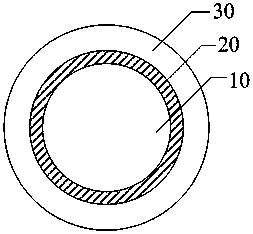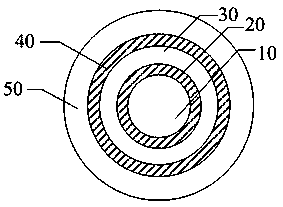Quantum dot composition and preparation method thereof
A technology of quantum dots and compositions, applied in the field of quantum dots, can solve the problems of poor performance of quantum dot compositions, achieve the effects of improving luminous efficiency and size uniformity, reducing surface defects, and high luminous efficiency
- Summary
- Abstract
- Description
- Claims
- Application Information
AI Technical Summary
Problems solved by technology
Method used
Image
Examples
Embodiment I
[0136] The preparation of the InP quantum dot core of this embodiment comprises the following steps:
[0137] Add 0.14 mmol of indium acetate, 0.6 mmol of oleic acid and 20 g of octadecene into a 100 mL three-necked flask, and exhaust at 150 degrees Celsius for 30 minutes to remove water and oxygen in the reaction system;
[0138] After the reaction system is filled with argon, the temperature is raised to 250 degrees Celsius;
[0139] Quickly inject 0.1 mmol P(TMS) into the reaction system 3 (Tri(trimethylsilyl)phosphine) and 2 mL of octadecene were reacted at 250 degrees Celsius for 20 minutes to obtain InP quantum dot cores.
Embodiment 2
[0141] The preparation of the InPZnS quantum dot nucleus of this embodiment comprises the following steps:
[0142] Add 0.18 mmol of indium chloride, 1 mL of tetrahydrofuran, 1 mmol of zinc acetate, 0.6 mL of oleic acid, and 9 mL of octadecene into a 100 mL three-neck flask, and ventilate at 150 °C for 30 minutes to remove water in the reaction system and oxygen;
[0143] After the reaction system is filled with argon, the temperature is raised to 280 degrees Celsius;
[0144] Quickly inject 0.06 mmol P(TMS) into the reaction system 3 (Tri(trimethylsilyl)phosphine), 0.4 mmol sulfur, 0.5 mL trioctylphosphine (TOP) and 0.5 mL octadecene, and reacted at 280 °C to obtain InPZnS quantum dot cores.
[0145] InPZnS quantum dot cores with different luminous wavelengths and luminous intensities can be obtained according to the reaction time. For example, the luminous wavelength of the InPZnS quantum dot core obtained after 20 seconds of reaction is 504 nm, and the luminous efficiency...
Embodiment 3
[0147] The preparation of the InPZnSe quantum dot nucleus of this embodiment comprises the following steps:
[0148] Add 0.16 mmol of indium chloride, 1 mL of tetrahydrofuran, 1 mmol of zinc acetate, 0.6 mL of oleic acid, and 9 mL of octadecene into a 100 mL three-neck flask, and ventilate at 150 °C for 30 minutes to remove water in the reaction system and oxygen;
[0149] After the reaction system is filled with argon, the temperature is raised to 300 degrees Celsius;
[0150] Quickly inject 0.12 mmol P(TMS) into the reaction system 3 (Tri(trimethylsilyl)phosphine), 0.02 mmol selenium, 0.5 mL trioctylphosphine (TOP) and 0.5 mL octadecene, and react at 300 degrees Celsius to obtain InPZnSe quantum dot cores.
[0151] InPZnSe quantum dot cores with different luminous wavelengths and luminous intensities can be obtained according to the reaction time. For example, the luminous wavelength of InPZnSe quantum dot cores obtained after 20 seconds of reaction is 503 nm, and the lumi...
PUM
| Property | Measurement | Unit |
|---|---|---|
| particle diameter | aaaaa | aaaaa |
| wavelength | aaaaa | aaaaa |
| particle diameter | aaaaa | aaaaa |
Abstract
Description
Claims
Application Information
 Login to View More
Login to View More - R&D
- Intellectual Property
- Life Sciences
- Materials
- Tech Scout
- Unparalleled Data Quality
- Higher Quality Content
- 60% Fewer Hallucinations
Browse by: Latest US Patents, China's latest patents, Technical Efficacy Thesaurus, Application Domain, Technology Topic, Popular Technical Reports.
© 2025 PatSnap. All rights reserved.Legal|Privacy policy|Modern Slavery Act Transparency Statement|Sitemap|About US| Contact US: help@patsnap.com


